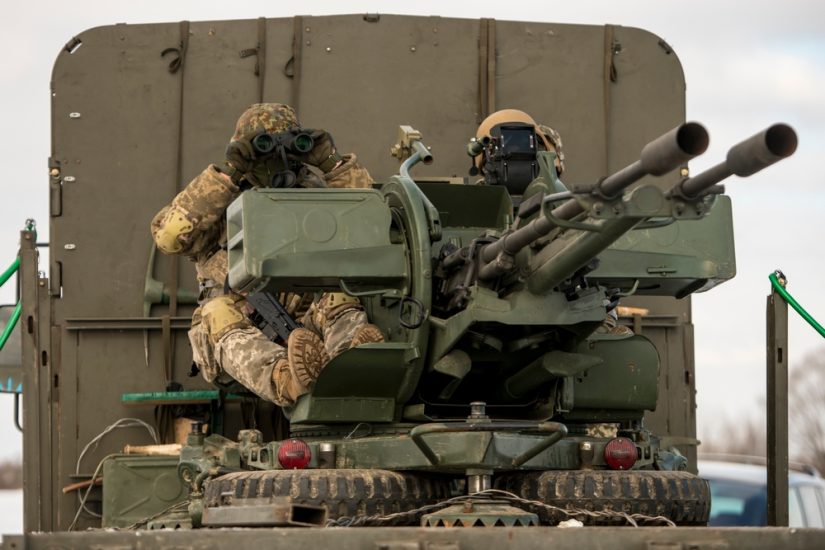by Tim Mahon
The C-UAS community – in common with almost every other sector of the broad defence and security worlds – focuses a great deal of attention on what is happening in Ukraine as the 21-month-old conflict with Russia continues to unfold. Almost every commercial or marketing presentation trumpets “this is what we learned – and this is what we’re doing about it”. Sometimes it takes an alternative perspective to stimulate a rethink and a re-evaluation of conventional wisdom. And that is just what happens on reading an account, recently published on social media, of a venture capitalist’s visit to the conflict area.
We will not attempt to summarise the article – that would be both grossly unfair and would rob the author of the benefit of readers perusing what he actually said, as opposed to what somebody else says he said: read the article linked below – you will be glad you did. It is, however, worth reflecting on some of the conclusions that the author highlights in his social media post, for they provide an alternative point of view and provoke constructive thought – which is never a bad thing! Admittedly, these conclusions derive from looking at the whole spectrum of the conflict – but they translate with terrifying ease to having significant potential impact on the development, acquisition and deployment of C-UAS solutions.
The first observation, as the author puts it, is that “the adversary has a plan for countering legacy concepts and capabilities,” which, he concludes, demands observing nations “design for adaptation”. Although Russian equipment (and doctrine and experience, in particular) have failed to live up to expectations – which will have a detrimental effect on the nation’s credibility and the long-term health of its defence export prospects – there is considerable evidence that some aspects of the potential countermeasures they may face were considered prior to the invasion, and supposedly adequate measures put in place. The fundamental problem with the apparent failure to defeat those countermeasures is an issue of training, doctrine and mission readiness (or lack thereof) rather than one of technology. Nevertheless, designing for adaptation is good advice, for the current mentality of the Russian military system does not react particularly effectively – or swiftly – to the unexpected.
The second conclusion unearths one of the abiding truths of modern conflict. “The contested electromagnetic spectrum shapes the employment of all other capabilities,” to which the suggested counter is “Invest in the ecosystem”. That is a graceful encapsulation of what so many developers are doing – and, to a certain extent, those are being echoed by the operators. The investment made in the last several generations of AI, autonomy, data fusion, sensor fusion and simple-to-use interfaces have the potential to transform modern warfare. Evidence from Ukraine – and elsewhere – currently suggests some of those effects are beginning to manifest, but resting on laurels is not an option. The imperative to invest in technological capability remains, if not paramount, then at least of supreme importance.
Yet the very next conclusion offered by the author appears to counter the argument above. “Combat forces on the modern battlefield have a preference for affordable mass over exquisite capability [therefore] Accelerate autonomy”. While we might argue with the potential universal applicability of the first part of that statement, there can be no doubt that some military cultures espouse exactly that concept. Russian use of EW drones in enormous numbers and their use of overwhelming artillery power are good examples of the concept at work. There is also the issue of the ‘affordable’ part of the statement – a word that in many other cultures becomes the rock on which other, wider-scale solutions often founder. Autonomy – safe, error-free, reliable and repeatable autonomous capability – will undoubtedly provide a competitive advantage in almost every conflict scenario currently being played out or foreseen. But there is still a phenomenal amount of work to be completed (and funded) before we get from where we are to where we aspire to be.
Finally, a truism that merits repetition, despite the fact the casual reader may ask “Isn’t that obvious?” Indeed it is – but it is also all too rarely highlighted as a current imperative. “Innovating under fire is hard, scaling innovation while under fire is harder”. If we, the external observers, should take to heart any lesson the Ukrainian armed forces and wider population are learning at such enormous human cost, this is it. Don’t spend too long observing, analysing, interpreting and discussing: start to build effective responses now or, as the author puts it, “Team and iterate now”.
It is almost always worth while considering perspectives from a different point of view, which is why Unmanned Airspace will continue to seek out and report on them when the subject matter and ‘alternative’ nature of the argument justify calling it to the attention of our global audience.
For more information: Startup Army: How the War in Ukraine is Rewriting the Future of Defense Tech (hs-sites.com)
(An air defence unit of the Ukrainian Armed Forces, in position near Ukraine’s northern border, February 2023 – Shutterstock)
Tim Mahon is Publishing Director – C-UAS at Unmanned Airspace




